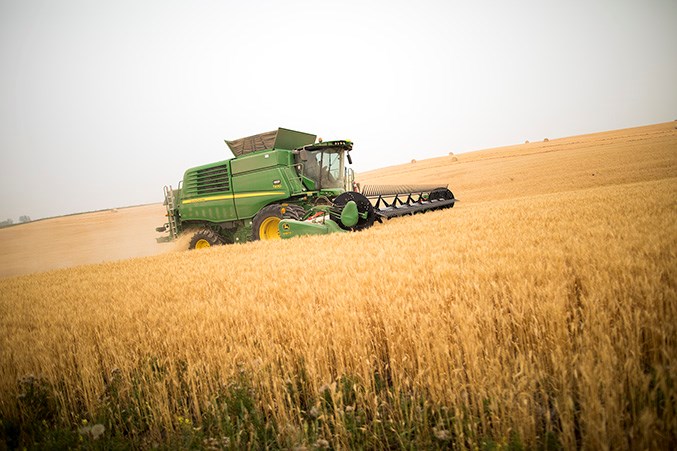It was a difficult harvest for Foothills area farmers. While some were lucky enough to get their crops off the ground before a month’s worth of wet weather hit in early September, not everyone was so fortunate. “It’s been a tough year,” said Blackie-area farmer Kelly Malmberg, who is also the agricultural fieldman for Vulcan County. As far as precipitation, he said his crops were on the borderline of being dry to average through the summer. In late August, he and his brother began harvesting their wheat crops and managed to lift about 75 per cent of their cereal grains before the rain started in the first week of September. The weather didn’t dry up again until Thanksgiving, and the rest of harvest had to wait until mid October, he said. “The quality really suffered for anything that sat out there for that month,” said Malmberg. “There’s a lot of feed grain and lower-graded crops.” The issue with cereal crops is when it sits in wet weather it starts to break down and germinate, which degrades the quality, he said. As far as other crops, like peas and canola, they’re a little hardier, he said. “They seem like they could sit through an apocalypse almost and it doesn’t really hurt them,” said Malmberg. “I had some canola left and it didn’t hurt it at all, and then I did have a little piece of wheat I didn’t get off and it did hurt it for quality.” His canola crop still came off as a number-one grade, he said. With the lower-grade crops harvested in October, he said the industry that will be largely effected will be breweries. “I don’t know if there’s a lot of malt barley this year,” said Malmberg. “It’s a finicky crop. You don’t want a hot year because it usually makes the protein in the barley high, which the brewers don’t like because they like low-protein barley, it brews better.” Most of the province’s malt barley crops suffered this year, whether in the south where hot and dry summer conditions and raised protein levels to the “grain belt” north of Calgary where barley was out in the rain through September, he said. There is one industry that will benefit from the number of low-grade crops that came out of harvest, he said. Cattle feeders, who were worried about feed supply this year because of dry conditions, will now have access to more graded grains that were turned into feed quality, he said. “If anything it helped the feedlots, because they didn’t think they’d have much feed this year,” said Malmberg. But it won’t necessarily help everyone raising cattle, he said. “The farm guy, the cattle guy that’s feeding cows this winter, it’s going to be tough because feed prices are going to be high,” said Malmberg. “Feedlot guys, they’re going to pick up a lot of feed grain that laid out in the field.” Jeff Porter, agriculture services manager for the MD of Foothills, said this year was a “nightmare harvest.” For the most part, yields were average to below average, he said, and quality suffered. “Depending on where you got the showers this year, some guys might have had some decent yields but again quality was not great,” said Porter. He said there will be an impact on grain prices, where a lot of farmers will see losses – though it depends on how the overall harvest came off, he said. If quality was down everywhere, which Porter said is likely, producers will be looking for half-decent grains to get by. “So some of those feed-grades might get bumped up a bit, or they might get a better grain price for it,” said Porter. He said farmers in the MD managed to get a good run in the latter part of October with drier conditions. Some were still forced to take their crops off at higher moisture levels to stay ahead of winter weather, he said. “There’s going to be a lot of people moving grain when it’s cold like this to cool it down and get some aeration,” said Porter. “There are probably guys buying aeration for their bins. Guys that are already set up with air and heat, they’d be drying their grain down in the bin.”




.png;w=120;h=80;mode=crop)